We live in about a 200-year-old converted cottage. It’s on the earliest maps of Ireland. We’re nestled in Castlelyons, the home of the Bride Project, which is all about Farming for Nature.
The community is very much interested in biodiversity and there’s great action around here.
We bought this house when there was nothing on the market. It was a one bedroom house with almost an acre of land. When we bought it, I was seven-months pregnant and we had a three-year-old.
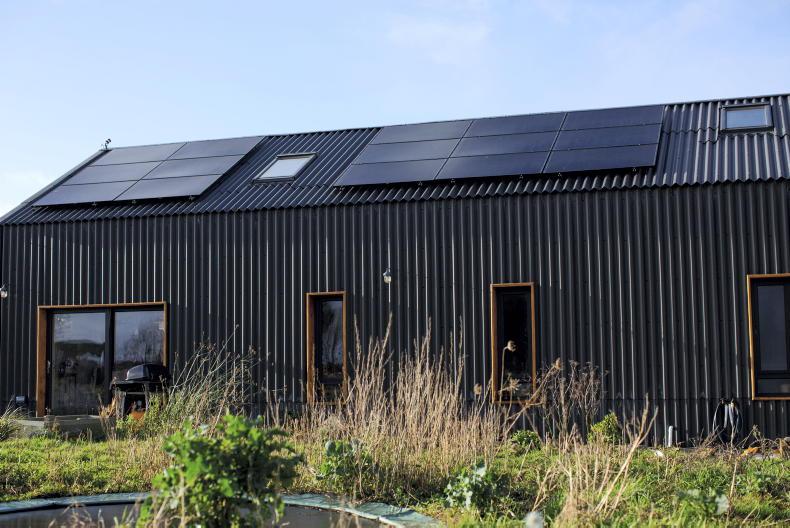
Molly and Shane wanted the outside of their home to respect the original cottage, so they went agricultural for its exterior design . \ Molly Ellis
I’m self-employed as an artist; my own work is quite traditional. I’m a wildlife artist, I use just coloured wool and a single needle. It’s all Irish wildlife and it’s all [done] using natural, hand-dyed fibres.
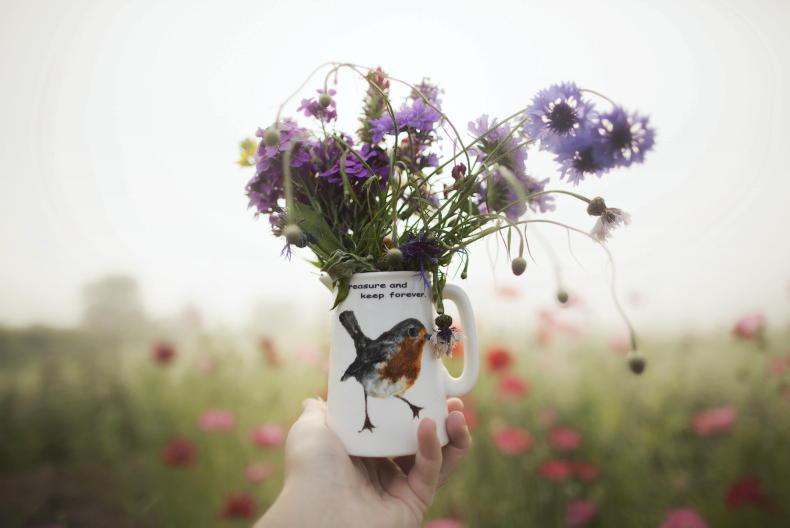
Co Cork Artist Molly Ellis has been on a journey, along with her husband Shane and their two children, to decarbonise their lives.
Even when we lived in rentals, we always explored [alternative] energy and were interested in the idea of decarbonisation, which really means reducing our reliance on fossil fuels in our day to day lives. One thing we did was build our own wind turbine on a mountain in Cahersiveen (where we used to live) and we used it to power my art studio. When we had to do maintenance it was a three-man job and we used to invite friends to stay and help!
Forever home
I also have two small children and they are autistic. So when we designed our home, we designed it with them in mind – not just for their sensory needs, but with the idea that this is their home forever. We wanted somewhere they could feel safe and be themselves.
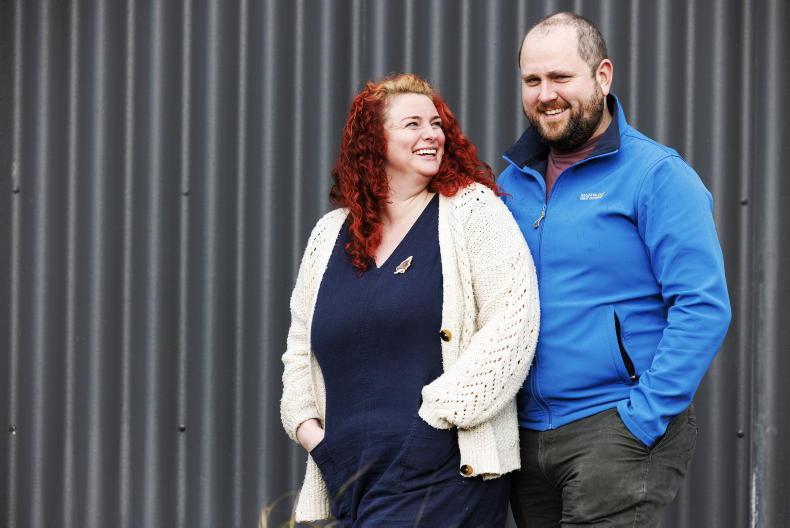
Molly Ellis and Shane O’Sullivan. \ Donal O’Leary
Originally, we were just going to do an extension. We had to take our time to save money. The more we thought about it, we were balancing building a house our children would love but also a house they could be proud of in their future. Again it came to budget – we had an old house we had done very little to and we had to live there while we were retrofitting or building. We came up with a plan to build an open-plan space and link the old with the new.
It’s an agricultural look to respect the cottage heritage. It looks like a big barn basically, and the link is the entrance way.
Solar adventure
We approached an alternative energy company for our heat pump. They helped up plan what cables went where for when we could afford the next step. We wouldn’t have known to future plan otherwise.
We got the €3,000 grant for the solar panels and battery storage, which we put in a few months after it had been built (when our budget permitted). Now that we are in, the heat pump runs at night time when electricity is cheaper and the extension stays warm all day.
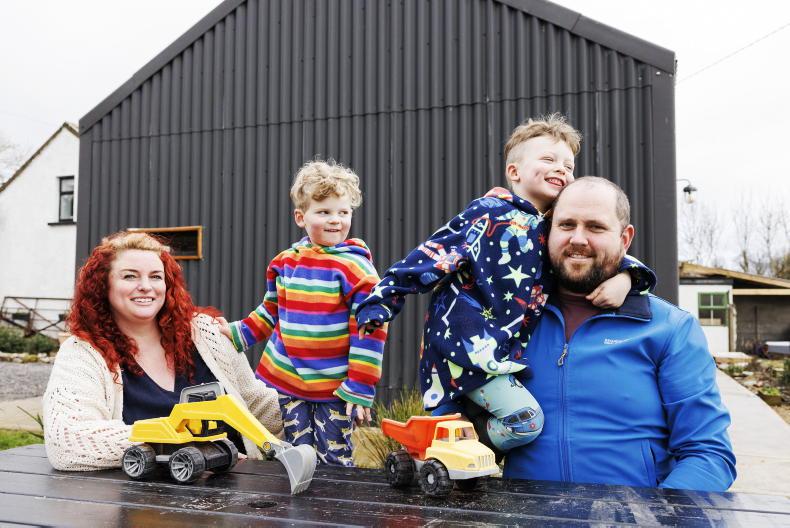
Molly Ellis and Shane O’Sullivan with their sons Finn and Miles at home at Bawnard Cottage. \ Donal O’Leary
During construction, we stayed with family for two weeks but, for the rest of the build, we were living in the cottage and it was tough – the builders understood they needed to work quickly so we weren’t living in a building site.
The old cottage still has poor insulation and is draughty but it will have to wait until we have the budget to upgrade it properly. We chose to put all of our budget into this really warm extension to live and balance that energy. We didn’t apply for other grants because, among other things, we knew there would have been an expectation to do work to the cottage which we weren’t financially in a position to do.
Going electric
Several years ago, we were in Spain and saw this electric car. We heard this zoom and it was like a UFO passing.
My husband said: “My next car is going to be an electric car,” and I laughed. At this time, he was doing a heavy commute on an old diesel car. This was what we could afford and, for us, it was the best option.
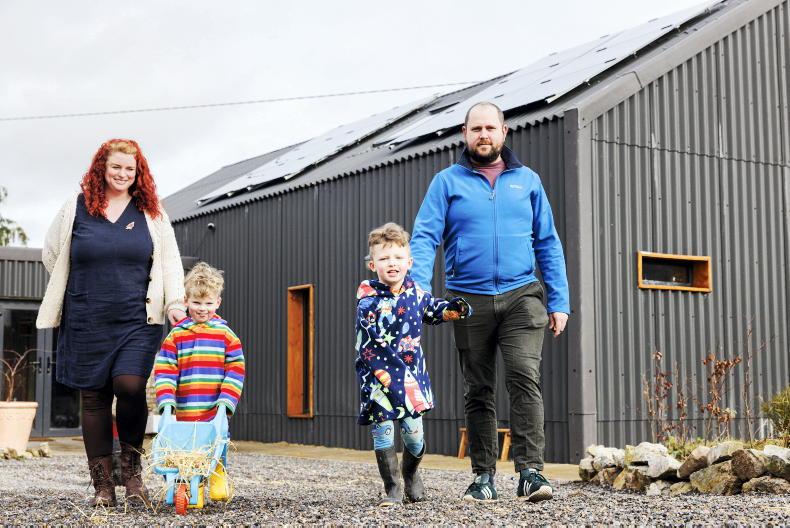
Then we worked out that, to get a newer car financed, the monthly payments would be the same as what we were spending on diesel. He went from paying €300 per month on diesel to paying the same, but on a newer car with no diesel bills. This was revolutionary for us. We bought a secondhand ex-demo from the UK, which is how we could afford it.
We made sacrifices with that car – we go to Fermoy from Cahirsiveen regularly and the network is poor. At the time, this car had a good range, but nothing like [electric cars] now.
The network is still terrible – so much needs to change – but in the last six weeks I’ve only used a public charging station once, for ten minutes
We knew from the savings alone that we would someday get a second electric vehicle, but we didn’t have the budget. Just six weeks ago we got our second car. Again, we went secondhand as we couldn’t afford new.
Because these cars have less storage, we waited until the kids were three and five and didn’t need prams anymore.
The network is still terrible – so much needs to change – but in the last six weeks I’ve only used a public charging station once, for ten minutes (it was fast charging). It’s a different world now from when we had a newborn and charging took 40 minutes!
What’s the payback?
People always ask us about payback on things like EVs, heat pumps and solar panels – and we feel like that was never in our conversation. You have a dishwasher – what is the payback on that? I know my experience, and my experience is that it’s convenient. We charge our cars six months of the year pretty much for free from solar panels.
On a sunny spring day, we might get 40km of charge. On a really good summer day we might get 200km of solar charge.
We have battery storage which charges at night in the winter
Two years ago, it cost us €1,500 annually to heat our small cottage. Last year, our entire electricity costs including heating and one electric vehicle was €1,819.60 on a house twice the size. We can track all this with the energy monitoring system installed.
We are paying for electricity, but just for six months a year - the rest of the time it’s free. We have battery storage which charges at night in the winter, so while I can turn on my washing machine during the day, I’m running off the night-time rates (the night-time grid is largely run by wind power which is more sustainable).
I do understand that this is unaffordable for a lot of people. I understand that because we had to balance a lot to get here and it’s still a continual journey. We just wanted to share it is possible to begin.
Read more
‘A lot of people say the dried flowers remind them of their granny’
My Country Living: Co Limerick wholefoods caterer Lizzy O'Connell
We live in about a 200-year-old converted cottage. It’s on the earliest maps of Ireland. We’re nestled in Castlelyons, the home of the Bride Project, which is all about Farming for Nature.
The community is very much interested in biodiversity and there’s great action around here.
We bought this house when there was nothing on the market. It was a one bedroom house with almost an acre of land. When we bought it, I was seven-months pregnant and we had a three-year-old.

Molly and Shane wanted the outside of their home to respect the original cottage, so they went agricultural for its exterior design . \ Molly Ellis
I’m self-employed as an artist; my own work is quite traditional. I’m a wildlife artist, I use just coloured wool and a single needle. It’s all Irish wildlife and it’s all [done] using natural, hand-dyed fibres.

Co Cork Artist Molly Ellis has been on a journey, along with her husband Shane and their two children, to decarbonise their lives.
Even when we lived in rentals, we always explored [alternative] energy and were interested in the idea of decarbonisation, which really means reducing our reliance on fossil fuels in our day to day lives. One thing we did was build our own wind turbine on a mountain in Cahersiveen (where we used to live) and we used it to power my art studio. When we had to do maintenance it was a three-man job and we used to invite friends to stay and help!
Forever home
I also have two small children and they are autistic. So when we designed our home, we designed it with them in mind – not just for their sensory needs, but with the idea that this is their home forever. We wanted somewhere they could feel safe and be themselves.

Molly Ellis and Shane O’Sullivan. \ Donal O’Leary
Originally, we were just going to do an extension. We had to take our time to save money. The more we thought about it, we were balancing building a house our children would love but also a house they could be proud of in their future. Again it came to budget – we had an old house we had done very little to and we had to live there while we were retrofitting or building. We came up with a plan to build an open-plan space and link the old with the new.
It’s an agricultural look to respect the cottage heritage. It looks like a big barn basically, and the link is the entrance way.
Solar adventure
We approached an alternative energy company for our heat pump. They helped up plan what cables went where for when we could afford the next step. We wouldn’t have known to future plan otherwise.
We got the €3,000 grant for the solar panels and battery storage, which we put in a few months after it had been built (when our budget permitted). Now that we are in, the heat pump runs at night time when electricity is cheaper and the extension stays warm all day.

Molly Ellis and Shane O’Sullivan with their sons Finn and Miles at home at Bawnard Cottage. \ Donal O’Leary
During construction, we stayed with family for two weeks but, for the rest of the build, we were living in the cottage and it was tough – the builders understood they needed to work quickly so we weren’t living in a building site.
The old cottage still has poor insulation and is draughty but it will have to wait until we have the budget to upgrade it properly. We chose to put all of our budget into this really warm extension to live and balance that energy. We didn’t apply for other grants because, among other things, we knew there would have been an expectation to do work to the cottage which we weren’t financially in a position to do.
Going electric
Several years ago, we were in Spain and saw this electric car. We heard this zoom and it was like a UFO passing.
My husband said: “My next car is going to be an electric car,” and I laughed. At this time, he was doing a heavy commute on an old diesel car. This was what we could afford and, for us, it was the best option.

Then we worked out that, to get a newer car financed, the monthly payments would be the same as what we were spending on diesel. He went from paying €300 per month on diesel to paying the same, but on a newer car with no diesel bills. This was revolutionary for us. We bought a secondhand ex-demo from the UK, which is how we could afford it.
We made sacrifices with that car – we go to Fermoy from Cahirsiveen regularly and the network is poor. At the time, this car had a good range, but nothing like [electric cars] now.
The network is still terrible – so much needs to change – but in the last six weeks I’ve only used a public charging station once, for ten minutes
We knew from the savings alone that we would someday get a second electric vehicle, but we didn’t have the budget. Just six weeks ago we got our second car. Again, we went secondhand as we couldn’t afford new.
Because these cars have less storage, we waited until the kids were three and five and didn’t need prams anymore.
The network is still terrible – so much needs to change – but in the last six weeks I’ve only used a public charging station once, for ten minutes (it was fast charging). It’s a different world now from when we had a newborn and charging took 40 minutes!
What’s the payback?
People always ask us about payback on things like EVs, heat pumps and solar panels – and we feel like that was never in our conversation. You have a dishwasher – what is the payback on that? I know my experience, and my experience is that it’s convenient. We charge our cars six months of the year pretty much for free from solar panels.
On a sunny spring day, we might get 40km of charge. On a really good summer day we might get 200km of solar charge.
We have battery storage which charges at night in the winter
Two years ago, it cost us €1,500 annually to heat our small cottage. Last year, our entire electricity costs including heating and one electric vehicle was €1,819.60 on a house twice the size. We can track all this with the energy monitoring system installed.
We are paying for electricity, but just for six months a year - the rest of the time it’s free. We have battery storage which charges at night in the winter, so while I can turn on my washing machine during the day, I’m running off the night-time rates (the night-time grid is largely run by wind power which is more sustainable).
I do understand that this is unaffordable for a lot of people. I understand that because we had to balance a lot to get here and it’s still a continual journey. We just wanted to share it is possible to begin.
Read more
‘A lot of people say the dried flowers remind them of their granny’
My Country Living: Co Limerick wholefoods caterer Lizzy O'Connell












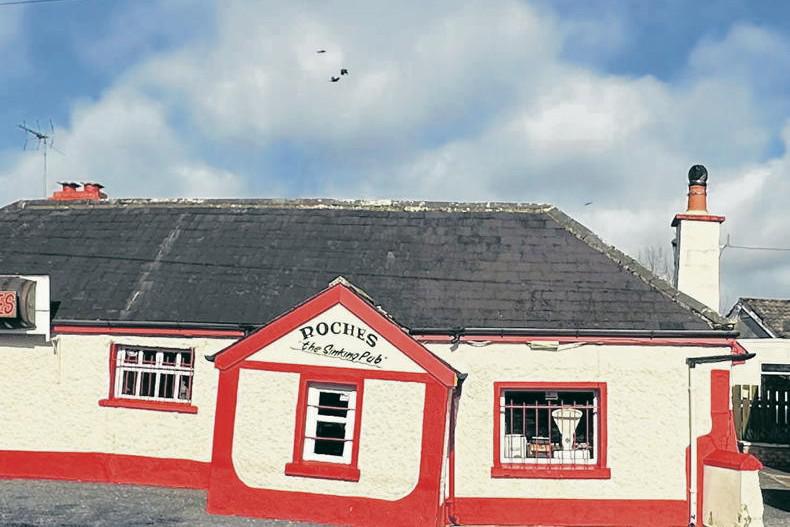
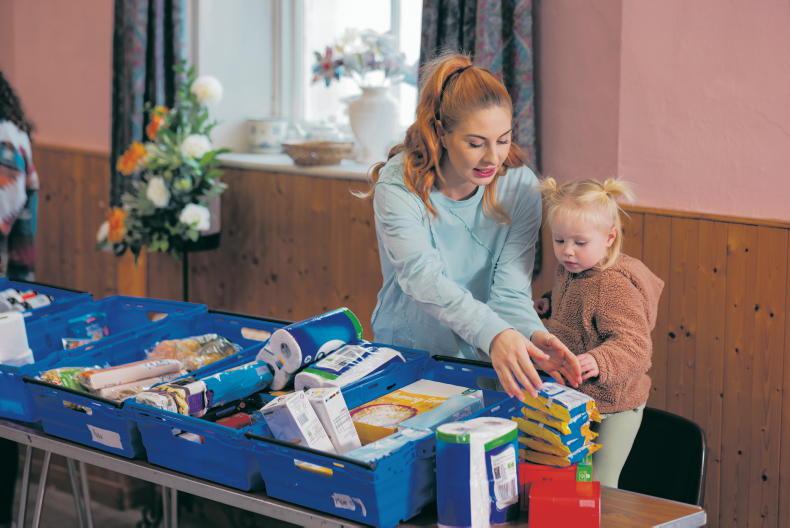
SHARING OPTIONS